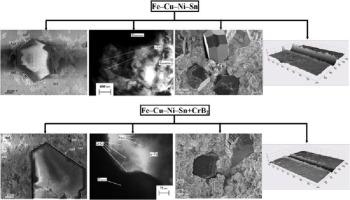International Journal of Refractory Metals & Hard Materials ( IF 3.6 ) Pub Date : 2021-07-29 , DOI: 10.1016/j.ijrmhm.2021.105655 V.A. Mechnik 1 , M.O. Bondarenko 1 , V.M. Kolodnitskyi 1 , V.I. Zakiev 2 , I.M. Zakiev 2 , M.О. Kuzin 3 , E.S. Gevorkyan 4

|
The influence of CrB2 additive (within the interval ranging from 0 to 8 wt%) on the formation of structure of the diamond–matrix transition zone and the matrix material, microhardness, elastic modulus, retention of diamond grains in Fe–Cu–Ni–Sn matrix material and wear resistance of sintered diamond-containing composites (DCCs) by the powder metallurgy method has been studied. Micro-mechanical and tribological tests were conducted using composite samples 10 mm in diameter and 5 mm thick. It has been established that the transition zone structure significantly depends on the CrB2 content in a composite and is of a different nature than that of the matrix material. The structure of DCCs transition zone based on 51Fe–32Cu–9Ni–8Sn matrix consists of Cu, α-Fe and Ni3Sn phases with graphite inclusions. The structure of DCCs transition zone based on 51Fe–32Cu–9Ni–8Sn matrix with CrB2 additives consists of the α-Fe phase and Fe3C, Cr7C3, Cr3C2 carbide layers without graphite inclusions.
It has been shown that the hardness and the elastic modulus of sintered composite matrix material increase linearly as the concentration of CrB2 in their content increases while the wear rate decreases. The addition of 2 wt% of CrB2 to 51Fe–32Cu–9Ni–8Sn composite contributes to an increase in its hardness from 4.475 to 7.896 GPa and elastic modulus from 86.6 to 107.5 GPa thus reducing the wear rate from 21.61 × 10−6 to 10.04 × 10−6 mm3 N−1 m−1. The mechanism for enhancing the mechanical properties and wear resistance of DCCs samples containing CrB2 additives consists in refining of matrix phases of iron and copper from 25 μm to 10 μm and binding the carbon released during the graphitization of diamond grains to Fe3C, Cr7C3, Cr3C2 nanoscale carbides. This, in turn, increases the ability of matrix material to keep diamond grains from falling out during DCCs operation. Low values of mechanical properties and wear resistance of the initial (51Fe–32Cu–9Ni–8Sn) composite are attributed to the coarse-grained structure and formation of graphite inclusions in the diamond–matrix transition zone, causing its premature destruction and separation of diamond grains from the DCCs matrix.
中文翻译:

金刚石-基体过渡区结构对不同 CrB2 含量的 Fe-Cu-Ni-Sn 基体烧结含金刚石复合材料力学性能和磨损的影响
CrB 2添加剂(0~8 wt%范围内)对金刚石-基体过渡区结构形成和基体材料、显微硬度、弹性模量、金刚石晶粒在Fe-Cu-Ni中的保留的影响-Sn 基体材料和烧结含金刚石复合材料 (DCC) 的耐磨性已通过粉末冶金方法进行了研究。使用直径为 10 毫米、厚度为 5 毫米的复合样品进行了微机械和摩擦学测试。已经确定,过渡区结构显着取决于复合材料中的 CrB 2含量,并且与基体材料的性质不同。基于 51Fe-32Cu-9Ni-8Sn 基体的 DCCs 过渡区结构由 Cu、α-Fe 和 Ni 3 组成带有石墨夹杂物的 Sn 相。基于 51Fe-32Cu-9Ni-8Sn 基体和 CrB 2添加剂的 DCCs 过渡区结构由 α-Fe 相和 Fe 3 C、Cr 7 C 3、Cr 3 C 2碳化物层组成,没有石墨夹杂物。
研究表明,烧结复合基体材料的硬度和弹性模量随着其含量中CrB 2浓度的增加而线性增加,而磨损率降低。在51Fe-32Cu-9Ni-8Sn 复合材料中添加 2 wt% 的 CrB 2使其硬度从 4.475 GPa 增加到 7.896 GPa,弹性模量从 86.6 GPa 增加到 107.5 GPa,从而将磨损率从 21.61 × 10 -6 降低到10.04 × 10 -6 mm 3 N -1 m -1。含CrB 2的DCCs样品提高力学性能和耐磨性的机理添加剂包括将铁和铜的基体相从 25 μm 精炼到 10 μm,并将金刚石晶粒石墨化过程中释放的碳与 Fe 3 C、Cr 7 C 3、Cr 3 C 2纳米级碳化物结合。这反过来又增加了基质材料在 DCC 操作期间防止金刚石颗粒脱落的能力。初始 (51Fe-32Cu-9Ni-8Sn) 复合材料的低机械性能和耐磨性值归因于粗晶结构和金刚石-基体过渡区石墨夹杂物的形成,导致其过早破坏和分离金刚石来自 DCCs 基质的晶粒。



























 京公网安备 11010802027423号
京公网安备 11010802027423号